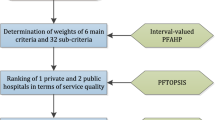Abstract
In hospital management, it is often observed that each decision making unit is under different and uncontrollable conditions. Consequently, comparing the units to each other cannot necessarily identify ineffectiveness of the units. This paper suggests the manager of a hospital to implement self-assessment technique for measuring the efficiency. The objective of this paper is to measure the efficiency of parallel system in intuitionistic fuzzy environment by introducing self-assessment technique which is the best type of evaluation where the maximum stability of the conditions is considered. The proposed model evaluates the performance of system and processes and determines the reasons of inefficiency in order to reduce the risk of lack of information about decision and deal with vague and complex conditions in real world.






Similar content being viewed by others
References
Castelli L, Pesenti R, Ukovich W (2004) DEA-like models for the efficiency evaluation of hierarchically structured units. Eur J Oper Res 154(2):465–476
Charnes A, Cooper WW, Rhodes E (1978) Measuring the efficiency of decision making units. Eur J Oper Res 2(6):429–444
Chowdhury H, Zelenyuk V (2016) Performance of hospital services in Ontario: DEA with truncated regression approach. Omega 63:111–122
Färe R (1991) Measuring Farrell efficiency for a firm with intermediate inputs. Academia Economic Papers 19(2):329–340
Garcia-Lacalle J, Martin E (2010) Rural vs urban hospital performance in a ‘competitive’public health service. Soc Sci Med 71(6):1131–1140
Grzegorzewski P (2003) Distances and orderings in a family of intuitionistic fuzzy numbers. In: Paper presented at the EUSFLAT Conf, pp 223–227
Hajiagha SRH, Akrami H, Kazimieras Zavadskas E, Hashemi SS (2013) An intuitionistic fuzzy data envelopment analysis for efficiency evaluation under uncertainty: case of a finance and credit institution. E a M: Ekonomie a Management 161:128–137
Kao C (2009) Efficiency measurement for parallel production systems. Eur J Oper Res 196(3):1107–1112
Kao C (2012) Efficiency decomposition for parallel production systems. J Oper Res Soc 63(1):64–71
Kao C (2014) Efficiency decomposition for general multi-stage systems in data envelopment analysis. Eur J Oper Res 232(1):117–124
Kao C, Hwang S-N (2008) Efficiency decomposition in two-stage data envelopment analysis: an application to non-life insurance companies in Taiwan. Eur J Oper Res 185(1):418–429
Kao C, Lin P-H (2012) Efficiency of parallel production systems with fuzzy data. Fuzzy Sets Syst 198:83–98
Mahapatra G, Roy T (2009) Reliability evaluation using triangular intuitionistic fuzzy numbers arithmetic operations. World Acad Sci Eng Technol 3(2):350–357
Nagoorgani A, Ponnalagu K (2012) A new approach on solving intuitionistic fuzzy linear programming problem. Appl Math Sci 6(70):3467–3474
Nedelea IC, Fannin JM (2013) Analyzing cost efficiency of critical access hospitals. J Policy Model 35(1):183–195
Puri J, Yadav SP (2015) Intuitionistic fuzzy data envelopment analysis: an application to the banking sector in India. Expert Syst Appl 42(11):4982–4998
Rosko MD, Mutter RL (2011) What have we learned from the application of stochastic frontier analysis to US hospitals? Med Care Res Rev 68:75S–100S
Zimmermann HJ (1996) Fuzzy set theory and its applications, 4th edn. Kluwer, Boston
Author information
Authors and Affiliations
Corresponding author
Ethics declarations
Conflict of interest
The authors do hereby declare that there is no conflict of interests of other works regarding the publication of this paper.
Human and animal rights
This article does not contain any studies with human participants or animals performed by any of the authors.
Additional information
Communicated by V. Loia.
Publisher's Note
Springer Nature remains neutral with regard to jurisdictional claims in published maps and institutional affiliations.
Rights and permissions
About this article
Cite this article
Ameri, Z., Sana, S.S. & Sheikh, R. Self-assessment of parallel network systems with intuitionistic fuzzy data: a case study. Soft Comput 23, 12821–12832 (2019). https://doi.org/10.1007/s00500-019-03835-5
Published:
Issue Date:
DOI: https://doi.org/10.1007/s00500-019-03835-5




